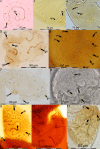Advances in Glomeromycota taxonomy and classification
- PMID: 22679604
- PMCID: PMC3359817
- DOI: 10.5598/imafungus.2011.02.02.10
Advances in Glomeromycota taxonomy and classification
Abstract
Concomitant morphological and molecular analyses have led to major breakthroughs in the taxonomic organization of the phylum Glomeromycota. Fungi in this phylum are known to form arbuscular mycorrhiza, and so far three classes, five orders, 14 families and 29 genera have been described. Sensulato, spore formation in 10 of the arbuscular mycorrhiza-forming genera is exclusively glomoid, one is gigasporoid, seven are scutellosporoid, four are entrophosporoid, two are acaulosporoid, and one is pacisporoid. Spore bimorphism is found in three genera, and one genus is associated with cyanobacteria. Here we present the current classification developed in several recent publications and provide a summary to facilitate the identification of taxa from genus to class level.
Keywords: Archaeosporomycetes; Gigasporales; Glomerales; Glomeromycetes; Paraglomeromycetes; VA mycorrhiza; endomycorrhizas; evolution; phylogeny.
Figures



Similar articles
-
Conserved Proteins of the RNA Interference System in the Arbuscular Mycorrhizal Fungus Rhizoglomus irregulare Provide New Insight into the Evolutionary History of Glomeromycota.Genome Biol Evol. 2018 Jan 1;10(1):328-343. doi: 10.1093/gbe/evy002. Genome Biol Evol. 2018. PMID: 29329439 Free PMC article.
-
A new order, Entrophosporales, and three new Entrophospora species in Glomeromycota.Front Microbiol. 2022 Nov 29;13:962856. doi: 10.3389/fmicb.2022.962856. eCollection 2022. Front Microbiol. 2022. PMID: 36643412 Free PMC article.
-
Taxonomic revision transferring species in Kuklospora to Acaulospora (Glomeromycota) and a description of Acaulospora colliculosa sp. nov. from field collected spores.Mycologia. 2010 Nov-Dec;102(6):1497-509. doi: 10.3852/10-011. Epub 2010 May 26. Mycologia. 2010. PMID: 20943549
-
A history of the taxonomy and systematics of arbuscular mycorrhizal fungi belonging to the phylum Glomeromycota.Mycorrhiza. 2012 May;22(4):247-58. doi: 10.1007/s00572-012-0432-4. Epub 2012 Mar 6. Mycorrhiza. 2012. PMID: 22391803 Review.
-
A Systematic Review of the Effects of Arbuscular Mycorrhizal Fungi on Root-Lesion Nematodes, Pratylenchus spp.Front Plant Sci. 2020 Jul 14;11:923. doi: 10.3389/fpls.2020.00923. eCollection 2020. Front Plant Sci. 2020. PMID: 32765542 Free PMC article.
Cited by
-
An evidence-based consensus for the classification of arbuscular mycorrhizal fungi (Glomeromycota).Mycorrhiza. 2013 Oct;23(7):515-31. doi: 10.1007/s00572-013-0486-y. Epub 2013 Apr 5. Mycorrhiza. 2013. PMID: 23558516 Review.
-
Arbuscular Mycorrhizal Fungi as Biostimulant and Biocontrol Agents: A Review.Microorganisms. 2024 Jun 24;12(7):1281. doi: 10.3390/microorganisms12071281. Microorganisms. 2024. PMID: 39065050 Free PMC article. Review.
-
Conserved Proteins of the RNA Interference System in the Arbuscular Mycorrhizal Fungus Rhizoglomus irregulare Provide New Insight into the Evolutionary History of Glomeromycota.Genome Biol Evol. 2018 Jan 1;10(1):328-343. doi: 10.1093/gbe/evy002. Genome Biol Evol. 2018. PMID: 29329439 Free PMC article.
-
Effects of inoculation by arbuscular mycorrhizal fungi on the composition of the essential oil, plant growth, and lipoxygenase activity of Piper aduncum L.AMB Express. 2019 Feb 26;9(1):29. doi: 10.1186/s13568-019-0756-y. AMB Express. 2019. PMID: 30806846 Free PMC article.
-
Comparative Analysis of Rhizosphere Fungal Communities in Korean Fir Trees.Mycobiology. 2024 Oct 10;52(5):287-297. doi: 10.1080/12298093.2024.2397857. eCollection 2024. Mycobiology. 2024. PMID: 39649144 Free PMC article.
References
-
- Błaszkowski J, Kovács GM, Balázs TK. (2009a) Glomus perpusillum, a new arbuscular mycorrhizal fungus. Mycologia 101: 247–255 - PubMed
-
- Błaszkowski J, Ryszka P, Oehl F, Koegel S, Wiemken A, et al. (2009b) Glomus achrum and G. bistratum, two new species of arbuscular mycorrhizal fungi (Glomeromycota). Botany 87: 260–271
-
- Błaszkowski J, Wubet T, Harikumar VS, Ryszka P, Buscot F. (2010a) Glomus indicum, a new arbuscular mycorrhizal fungus. Botany 88: 132–143
-
- Błaszkowski J, Kovács GM, Balázs TK, Orlowska E, Sadravi M, et al. (2010b) Glomus africanum and G. iranicum, two new species of arbuscular mycorrhizal fungi (Glomeromycota). Mycologia 102: 1450–1462 - PubMed
-
- Gerdemann JW, Trappe JM. (1974) The Endogonaceae of the Pacific Northwest. Mycologia Memoir 5: 1–76
LinkOut - more resources
Full Text Sources
